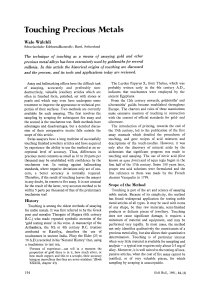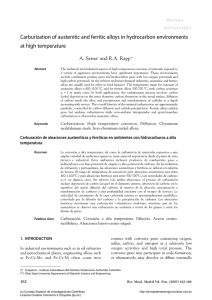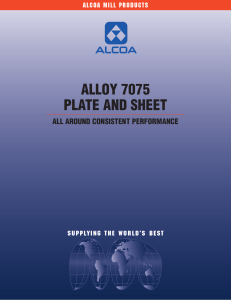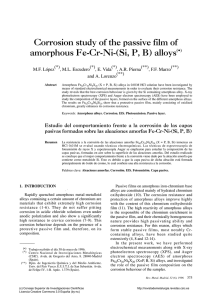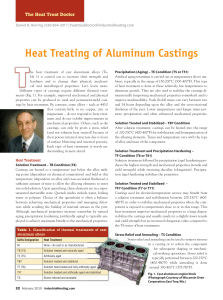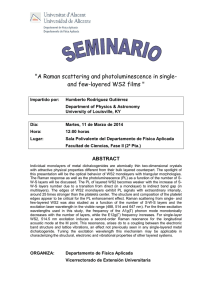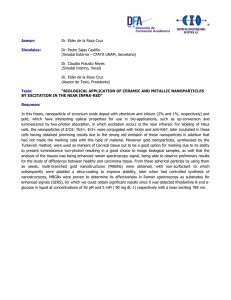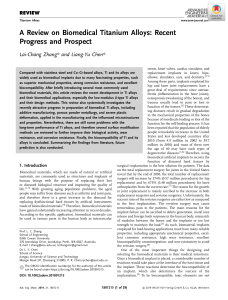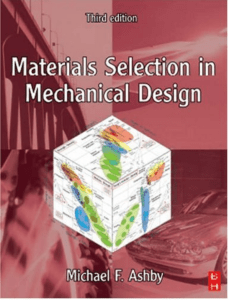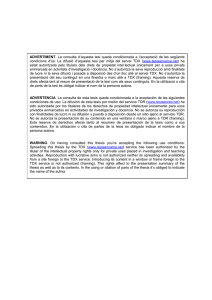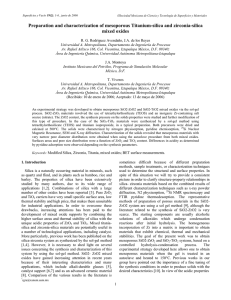Growth and characterization of Ge1
Anuncio
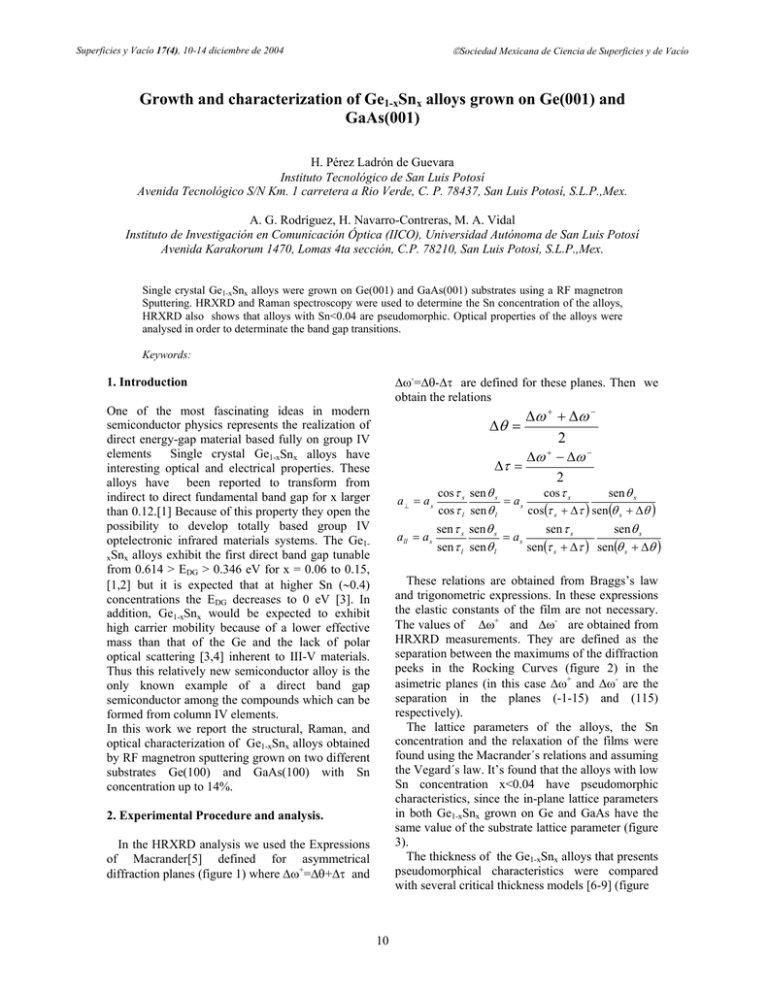
©Sociedad Mexicana de Ciencia de Superficies y de Vacío Superficies y Vacío 17(4), 10-14 diciembre de 2004 Growth and characterization of Ge1-xSnx alloys grown on Ge(001) and GaAs(001) H. Pérez Ladrón de Guevara Instituto Tecnológico de San Luis Potosí Avenida Tecnológico S/N Km. 1 carretera a Rio Verde, C. P. 78437, San Luis Potosí, S.L.P.,Mex. A. G. Rodríguez, H. Navarro-Contreras, M. A. Vidal Instituto de Investigación en Comunicación Óptica (IICO), Universidad Autónoma de San Luis Potosí Avenida Karakorum 1470, Lomas 4ta sección, C.P. 78210, San Luis Potosí, S.L.P.,Mex. Single crystal Ge1-xSnx alloys were grown on Ge(001) and GaAs(001) substrates using a RF magnetron Sputtering. HRXRD and Raman spectroscopy were used to determine the Sn concentration of the alloys, HRXRD also shows that alloys with Sn<0.04 are pseudomorphic. Optical properties of the alloys were analysed in order to determinate the band gap transitions. Keywords: ∆ω-=∆θ-∆τ are defined for these planes. Then we obtain the relations 1. Introduction One of the most fascinating ideas in modern semiconductor physics represents the realization of direct energy-gap material based fully on group IV elements Single crystal Ge1-xSnx alloys have interesting optical and electrical properties. These alloys have been reported to transform from indirect to direct fundamental band gap for x larger than 0.12.[1] Because of this property they open the possibility to develop totally based group IV optelectronic infrared materials systems. The Ge1xSnx alloys exhibit the first direct band gap tunable from 0.614 > EDG > 0.346 eV for x = 0.06 to 0.15, [1,2] but it is expected that at higher Sn (∼0.4) concentrations the EDG decreases to 0 eV [3]. In addition, Ge1-xSnx would be expected to exhibit high carrier mobility because of a lower effective mass than that of the Ge and the lack of polar optical scattering [3,4] inherent to III-V materials. Thus this relatively new semiconductor alloy is the only known example of a direct band gap semiconductor among the compounds which can be formed from column IV elements. In this work we report the structural, Raman, and optical characterization of Ge1-xSnx alloys obtained by RF magnetron sputtering grown on two different substrates Ge(100) and GaAs(100) with Sn concentration up to 14%. ∆θ = ∆τ = cos τ s a⊥ = as cos τ l sen τ s all = a s sen τ l ∆ω + + ∆ω − 2 + ∆ω − ∆ω − 2 sen θ s cos τ s sen θ s = as sen θ l cos(τ s + ∆τ ) sen (θ s + ∆θ ) sen θ s sen τ s sen θ s = as sen θ l sen(τ s + ∆τ ) sen(θ s + ∆θ ) These relations are obtained from Braggs’s law and trigonometric expressions. In these expressions the elastic constants of the film are not necessary. The values of ∆ω+ and ∆ω- are obtained from HRXRD measurements. They are defined as the separation between the maximums of the diffraction peeks in the Rocking Curves (figure 2) in the asimetric planes (in this case ∆ω+ and ∆ω- are the separation in the planes (-1-15) and (115) respectively). The lattice parameters of the alloys, the Sn concentration and the relaxation of the films were found using the Macrander´s relations and assuming the Vegard´s law. It’s found that the alloys with low Sn concentration x<0.04 have pseudomorphic characteristics, since the in-plane lattice parameters in both Ge1-xSnx grown on Ge and GaAs have the same value of the substrate lattice parameter (figure 3). The thickness of the Ge1-xSnx alloys that presents pseudomorphical characteristics were compared with several critical thickness models [6-9] (figure 2. Experimental Procedure and analysis. In the HRXRD analysis we used the Expressions of Macrander[5] defined for asymmetrical diffraction planes (figure 1) where ∆ω+=∆θ+∆τ and 10 ©Sociedad Mexicana de Ciencia de Superficies y de Vacío Superficies y Vacío 17(4), 10-14 diciembre de 2004 τs θs-τs 4). It was found that the only model in agreement with our results is the People and Bean model [9], this model was proposed for the Ge1-xSix alloy. This is a group IV alloy like Ge1-xSnx alloy and we believe that this is the reason for the agreement in the results. Raman spectroscopy was used to confirm the existence of the Ge1-xSnx alloys and as another way to determinate the Sn concentration according to the linear relation ∆ωGeSn = ω0 – 76.8cm-1 [10] ¨ for the Raman shift of the peak of Germanium from ω0 = 301.0 cm-1 (figure 5). It was found that the Sn concentration predicted by the Raman shift of the alloys is very near to the Sn concentration determinate by HRXRD as shown in figure 6. This results probes that Raman spectroscopy is another way to determine the Sn concentration of the alloys. The optical properties of the alloys were analysed using a FT-IR interferometer for measuring the transmittance of the Ge1-xSnx alloys. Transmittance measurements were performed for this alloys (figure 7) and hence the absorption coefficient were obtained for each sample (figure 8). The energy bandgap transition values were obtained by fitting the absorption edge with a model that includes the direct, indirect transitions and the Urbach’s tail energy. Also the critical points of the transmittance and the absorption coefficient, the parabolic approximations and the differentiates of this curves were considered. The determination of the change between indirect to direct band gap is not easy for Sn concentrations 0.6 < x < 0.13 due to the proximities of the gaps sometimes only a transition value is observed. However it’s possible to separate the gap values in alloys with higher Sn concentration. The experimental results obtained are not in agreement with the Tight-Binding model [3] or the PseudoPotential model [11] previously proposed. The data obtained are very nearly to the Potential of Deformation theory [12] results published recently and corroborated by FT-IR [1,2] and spectroscopic ellipsometry [13], these results are shown in figure 9. Although the change from indirect to direct band gap is expected by Potential of Deformation Theory around Sn = 10%, we only observe experimentally this change to Sn = 14%. τL θL+τL θL-τL θs+τs ∆τ dL - aS ll aS θs θs ds aS aS Figure 1. Diagram of a X-Ray diffraction on asymmetrical planes.as is the substrate lattice parameter, aL┴ and aLll are the in-growth and in-plane latitice parameters of the layer respectivaly, θs, θL, τs and τL are the bragg´s angles and the tilt angle of the plane of the substrate and layer respectivaly. SnxGe1-x/Ge/Ge(001) 0 Tg= 170 C x = 0.02 (004) x = 0.04 x = 0.09 Intensity (a. u.) x = 0.10 x = 0.14 SnxGe1-x/Ge/GaAs(001) 0 Tg= 150 C (004) x = 0.01 x = 0.06 x = 0.08 x = 0.09 31.5 32.0 32.5 33.0 Conclusions In conclusion, we have shown that it is possible to grow crystalline layers of Ge1-xSnx on Ge and GaAs substrates, with Sn concentration up to x = 0.14. Coherent Ge1-xSnx layers (x < 0.04) can be grown on Ge substrates according to People and Bean critical thickness model and therefore have ω/2θ (degrees) Figure 2. HRXRD rocking curves on the (004) plane of Ge1-xSnx alloys grown on Ge(100) and GaAs(100) substrates. The curves show the precense of epitaxial Ge1-xSnx layers. The Sn concentration is also shown for each curve. 11 ©Sociedad Mexicana de Ciencia de Superficies y de Vacío Superficies y Vacío 17(4), 10-14 diciembre de 2004 5.760 GeSn/Ge/Ge(100) SnxGe1-x/Ge/Ge(100) -1 Ge (301 cm ) 5.700 o a⊥ T=170 C a⎟⎟ P=5x10 mbar -2 GeSn128 (Sn 2%) abulk alloy GeSn abulk alloy Ge 5.670 Intensity (A.U.) lattice parameter (Å) 5.730 5.640 5.760 SnxGe1-x/Ge/GaAs(100) 5.730 GeSn127 (Sn 14%) GeSn126 (Sn 13%) 5.700 5.670 5.640 0.00 abulk alloy GaAs 0.02 0.04 0.06 0.08 0.10 GeSn125 (Sn 10%) 0.12 0.14 Sn concentration x 250 260 270 280 290 300 310 320 -1 Phonon Frecuency (cm ) Figure 3. The a⊥ (in-growth), a⎜⎢ (in-plane) and a0 (bulk) lattice parameters of the Ge1-xSnx alloys are shown as function of Sn concentration. GeSn/Ge/GaAs(100) -1 -1 -1 GaAs TO(268 cm ) GaAs LO(292 cm ) Ge(301 cm ) 10000 GeSn141 (Sn 8%) Frank and Van der Merwe [6] Geometrical [7] Matthews and Blakeslee [8] People and Bean [9] pseudomorphic layers 8000 6000 GeSn142 (Sn 8%) Intensity (A.U.) critical thickness hc(Å) Ge1-xSnx/Ge/Ge(100) 4000 2000 0 0.00 0.02 0.04 0.06 0.08 GeSn144 (Sn 7%) GeSn145 (Sn 6%) GeSn146 (Sn 9%) 0.10 Sn concentration x GeSn147 (Sn 7%) Figure 4. The thickness of the pseudomorphical Ge1-xSnx layers is compare with several critical thickness models reported everywere. [6-9] GeSn148 (Sn 7%) 250 260 270 280 290 300 310 320 -1 Phonon Frecuency (cm ) Figure 5. Raman measurements of the Ge1-xSnx alloys grown on Ge(100) and GaAs(100) substrates. The doted lines indicate the positions of the LO and TO modes of Ge and GaAs. The Sn concentration of the alloys is also shown. 12 ©Sociedad Mexicana de Ciencia de Superficies y de Vacío Superficies y Vacío 17(4), 10-14 diciembre de 2004 300 Ge1-XSnX/Ge/Ge(100) 299 Ge1-XSnX/Ge/GaAs(100) 298 297 148.41316 296 295 294 Absorption Coefficient (α) -1 Raman Shift (cm ) 301 293 292 291 290 289 0 1 2 3 4 5 6 7 8 9 10 11 12 13 14 15 Sn Concentration (%) by HRXRD Figure 6. Raman shift of the Ge1-xSnx alloys compare with the Sn concentration determined by HRXRD. The solid line is the Raman shift ∆ωGeSn = ω0 – 76.8cm-1 [10] reported for Ge1-xSnx alloys. EIndirect Sn=0.14 EDirect Ge GeSn/Ge/Ge(100) 0.10 54.59815 Ge Sn=0.14 0.09 0.2 0.3 0.4 0.08 0.07 0.6 0.7 0.8 0.9 Figure 8. Absorption coefficient obtained from the transmittance measurements of the Ge0.86Sn0.14 alloy. The determined direct and indirect band gap transitions of the alloy are shown. Sn=0.10 Transmittance 0.5 Energy (eV) 0.06 0.05 Sn=0.13 0.8 EcΓ Thigth-Binding 0.04 0.03 Energy (eV) 0.7 Sn=0.09 0.02 0.01 Sn=0.02 0.6 0.5 0.4 0.00 0.2 0.3 0.4 0.5 0.6 0.7 0.3 0.8 Energy (eV) Ec L Thigth-Binding 0.00 Direct Gap/Ge Indirect Gap/Ge Direct Gap/GaAs Indirect Gap/GaAs Direct Gap (M. R. Bauer et al.[9]) Direct Gap (Atwater et al.[1,2]) Indirect Gap (Atwater et al.[1,2]) 0.02 0.04 0.06 0.08 Ec L Pot. of Def. EcΓ Pot. of Def. 0.10 0.12 0.14 Sn concentration by HRXRD Figure 7. Transmittance measurements of the Ge1-xSnx alloys grown on Ge(100) substrates. The Sn concentration of th e alloys is shown for each curve. Figure 9. Experimentally energy Band Gap values of the Ge1-xSnx alloys compared with the predicted by the Potential of Deformation Theory. The Sn concentration values in the graph were determined by HRXRD. 13 ©Sociedad Mexicana de Ciencia de Superficies y de Vacío Superficies y Vacío 17(4), 10-14 diciembre de 2004 [6] F. C. Frank and J. H. Van der Merwe, Proc. Roy. Soc. (London) A 198 (1949) 216; J. H. Van der Merwe, J. Appl. Phys. Lett. 34 (1963) 117; J. H. Van der Merwe, In Single Cristal Films (Pergamon, New York, 1964) p. 139. [7] D. J. Dunstan, S. Young and R. H. Dixon, J. Appl. Phys 70 (6), 15 september 1991. [8] J. W. Matthews and A. E. Blakeslee, J. Of Crystal Growth, 27 (1974) p. 124. [9] R. People and J. C. Bean , Appl. Phys. Lett. 47 (3) August 1985. [10] M. Rojas-López, H. Navarro and J. Greene, J. Of Appl. Phys. 84, 2219 (1998). [11] K. A. Mäder, A. Baldereschi, Solid State Communications, 69, 12 (1989). [12] J. Barden, W. Shockley, Phys. Rev. 80,72 (1950). [13] M. Bauer, J. Tolle, C. Bungay, Solid Styate Communications, 127, 355 (2003). epilayers that are totally dislocations free. The Ge1xSnx alloys presents a tunable band gap. The values of the Direct and Indirect band gaps are very similar to the values predicted by the Potential of Deformation Theory. A direct transition is experimentally observed for alloys with Sn concentration up to 0.14. References [1] Gang He and Harry A. Atwater, Phys. Rev. Lett. 79, 1937 (1997). [2] Regina Ragan and Harry A. Atwater, Appl. Phys. Lett. 77, 3418 (2000). [3] D. W. Jenkins and J. D. Dow, Physical Rev. B 36, 7994 (1987). [4] S.I. Shah, J.E. Green, L. L. Abels, Qi Yao and P.M. Raccah, J. Crystal Growth 83, 3 (1987). [5] H. Pérez Ladrón de Guevara, A. Gaona Couto, M. A. Vidal, J. Luyo Alvarado, M. Meléndez Lira and M. López-López, J. Phys. D. 35, 1408 (2002). 14

